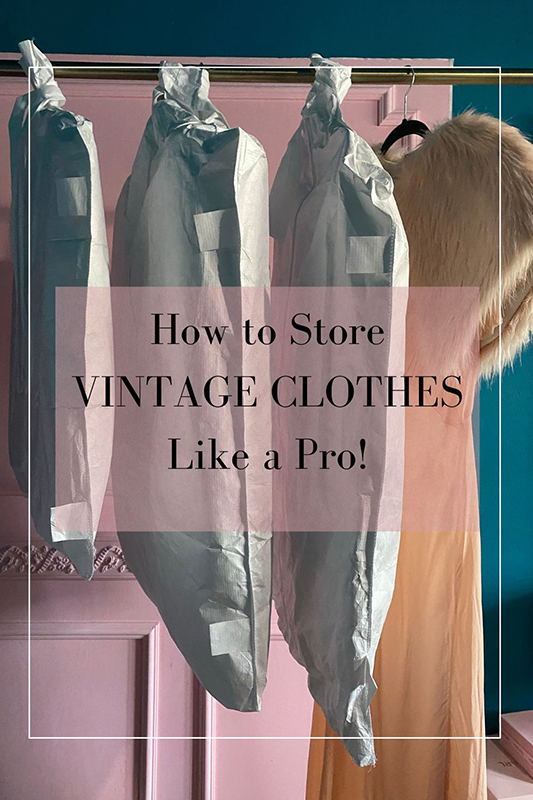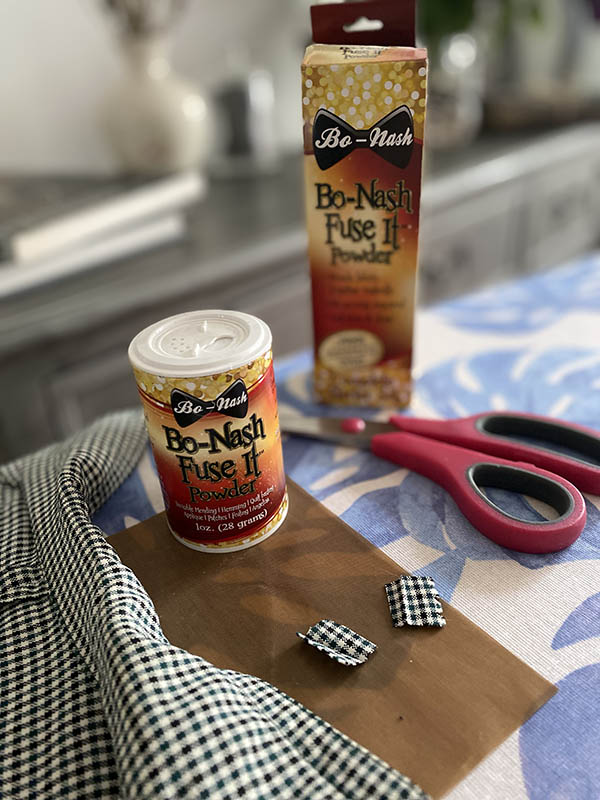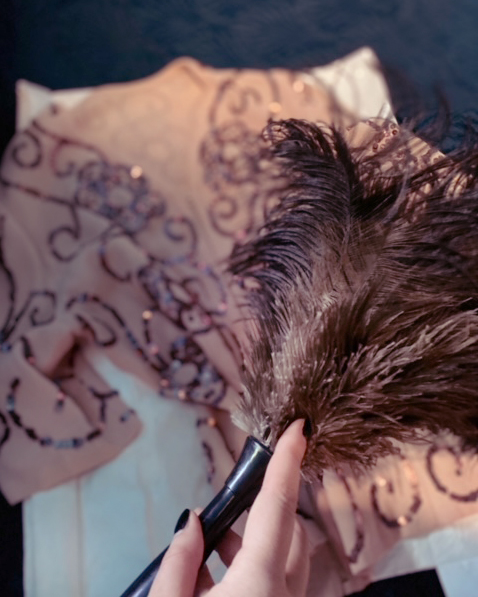How to Store Vintage Clothing Like a Pro!

Last updated on March 16th, 2024 at 07:44 pm
- The Must-Do Before Storing Vintage Clothes
- How To Fix a Hole in Vintage Clothes Without Sewing
- How To Clean Vintage Clothes
- Hand Washing Instructions-Vintage Clothes & Lingerie
- Learn How to Store Vintage Garments Like a Real Pro
- Storage Materials for Vintage Clothes
- Archival Tyvek Covers Come in Many Sizes
- Storing Vintage Clothes & Accessories in a Box
- The Danger of Hangers When Storing Vintage Clothes
- Rolled Storage
- Q & A with Barbara Czaja, textile conservator at the Museum of King Jan III’s Palace at Wilanow
In this article, you will learn how to store vintage clothing like a pro! I’ve already written about how to take care of vintage clothes, but this is a more in-depth piece.
To give you the best possible advice and to answer most, if not all, questions about the dos and don’ts of storing vintage clothing, I consulted with a professional textile conservator working for the Museum of King Jan III’s Palace at Wilanow.

The Must-Do Before Storing Vintage Clothes
- First, make sure that all your clothes are dust and pest-free before you store them!
- There is a brilliant Insect and Pest Guide on the Preservation Equipment website that will help you identify and fight the evil pest.
- Before you store your vintage treasures you will want to make sure they are clean. It’s also important to check for any tears and holes.
How To Fix a Hole in Vintage Clothes Without Sewing
DISCLOSURE; As of October 2021 I’m part of an affiliate program and I get a small commission for purchases made through some of the links in this post. When you purchase a product via the link in my post you are helping to keep my website alive for which I’m very grateful. All opinions expressed here are mine!
I don’t know about you but I’m awful at mending and I can’t sew at all. And that’s where Bo-Nash Fuse It Powder comes to the rescue! Here are step-by-step instructions and tips on how to fix a hole in clothes without stitching or sewing.

How To Clean Vintage Clothes
You can read all about cleaning vintage in my article “How to clean vintage clothes headache-free”.
- Eucalan detergent is my No1 choice for washing vintage and contemporary lingerie.

I receive a lot of e-mails about what detergent to use for washable vintage clothes. And I would like to emphasize the word, washable, because please remember, that there are fabrics that should never get into contact with water!
My favourite and the only detergent I use when washing vintage clothes and lingerie is *Tip. Always test for colour – fastness first!
Hand Washing Instructions-Vintage Clothes & Lingerie
- Fill the basin with tepid water.
- Add half the Eucalan cap to the water. [ you really don’t need much!]
- Soak the garment for 15 minutes.
- Squeeze gently. No rinse is required!
- To dry, lay the garment flat. I always place my freshly washed pieces on a towel.
2. Retro Clean-The Best Stain Remover
For getting rid of stubborn spots, yellow stains and dirt, I always use Retro Clean. It works every single time.


Learn How to Store Vintage Garments Like a Real Pro
Time needed: 6 minutes
How To Store Vintage Clothes Like a Pro!
- Firstly, before you store vintage clothes, make sure that all garments are clean and free from dust as well as pests. Remember that dust can cut fibre.
Inspect your vintage garments for any pest infestation. If you are not sure how to do it, the PEL website has an excellent guide on how to identify different types of pests and how to get rid of them without causing damage to vintage & antique clothes.

- Choose the right storage materials if you want to store vintage clothes the correct way.
For storing vintage clothes you can choose un-dyed cotton or muslin fabric, but only if the vintage clothes don’t have any decorative motives! That would be a big no-no for the late 1930s blouse embellished with sequins. On a side note, the blouse made an appearance in one of my favourite Bette Davis films, Old Acquaintance, 1943.

- Invest in Tyvek (1623E) archival garment covers or archival Tyvek roll that you can cut to the desired size.
Tyvek covers are lint-free, dust, pest and light-resistant. They come in many sizes. Preservation Equipment Ltd. launched this year a new product, the archival Tyvek bag for storing vintage & antique shoes. I use it for storing my vintage lingerie and gloves.

- Use acid-free unbuffered tissue paper & archival boxes to store your vintage clothes and accessories.
Place the acid-free unbuffered (don’t buy the buffered version) paper in your drawers, inside your hats, or use it to store your vintage & antique gloves. You can always choose the archival Tyvek shoe bag for storing vintage gloves. Archival boxes are brilliant for storing heavy vintage & antique dresses, capes and coats but they are very expensive.

- To store vintage clothes like a pro, don’t ever use wire, wooden, or plastic hangers.
Use conservation hangers for your precious vintage clothes. They come at a high price so alternatively, use Tyvek archival material (you can buy it in a roll) to wrap the coat hangers you already have. I use velour padded hangers that I cover with the archival Tyvek material so that the vintage garment is never in direct contact with the velour. Trust me, your precious vintage clothes will last you for many, many years to come if you store them the proper way.

Storage Materials for Vintage Clothes
- Fabric Materials
- Un-dyed cotton or muslin fabric.
*Tip. I also use 100% natural and undyed linen fabric but all textile conservators I spoke to use cotton and muslin.
Always wash the fabric you are going to use for storing vintage garments. The product recommended to me by several textile conservators is Orvus W.A. soap. You can buy it from preservationequipment.com or a saddlery shop.
- Tyvek (1623E) material is pH neutral and lint-free. It’s also very soft tear-resistant and breathable. Protects against pests, dust and light.
Archival Tyvek Covers Come in Many Sizes
I’m obsessed with Tyvek archival garment covers! As you can see in the picture below, the covers come in different sizes and you can easily fit two suits or blouses into one cover.
You can buy it in a roll and cut it to the desired size and shape. You can also purchase ready-made Tyvek Garment Covers which come in different sizes.

Archival Tyvek Shoe Bags-The Most Exciting Product Of The Year!
A must-have product for antique and vintage shoes but also brilliant for storing purses, lingerie and gloves!
The inner bags supplied in pairs come in three sizes;
- Small 450 x 200mm
- Medium 400 x 400mm
- Large 500 x 400mm
The outer bags with a hook and loop closure also come in three sizes;
- Small 500 x 500mm
- Medium 650 x 500mm
- Large 800 x 500mm



- Needle-punched (made without any adhesive) 100% non-woven polyester felt is great for the lining of drawers.
- Acid-free unbuffered tissue paper is the ideal wrapping material.
Don’t use buffered tissue paper as it’s damaging to silk and wool. In fact, I only ever buy acid-free unbuffered tissue paper. You can get it in sheets or rolls.
*I always buy mine in rolls and cut them to the desired size.
Storing Vintage Clothes & Accessories in a Box
- Archival cardboard box.
Many of the archival cardboard boxes available online are NOT acid-free. If you have the option of choosing a buffered or an unbuffered box, always choose the latter. Otherwise, wrap your vintage garment in unbuffered acid-free tissue paper.
- You can also use an archival plastic box because it doesn’t contain any additives and is more pest-proof than the archival cardboard box, but it’s not a cheap alternative.
*Every antique textile collector I know uses archival cardboard boxes.
WARNING! Never store your vintage clothing in a non-archival plastic box or an air-tight plastic bag!
The Danger of Hangers When Storing Vintage Clothes
The don’ts!

“No wire hangers, ever!” Said Faye Dunaway’s character in Mommie Dearest and right she was! After all, you don’t want to end up with rust on your precious clothes.
- Don’t use wooden hangers as they exude harmful materials that will be deadly to your vintage clothing.

*I’ve learned it the hard way by damaging a Victorian garment that I left on an antique wooden hanger.
- Don’t use plastic hangers either as they can be as harmful to vintage clothing as wooden ones.

If it’s possible, don’t use hangers at all or buy only conservation hangers. Unfortunately, they cost a fortune and take up a lot of space in the closet. You could make your own but the materials required for the padding are not cheap either.
- The cheaper alternative; cover your coat hangers with Tyvek fabric!
- I use velour hangers, mainly padded, which I wrap in either the Tyvek material or the unbuffered acid-free tissue paper.
- Never hang vintage garments that are made of; heavy fabric, embellished with sequins, beads or made of very delicate fabric that will easily tear.
On a separate note, my dream walk-in closet would consist only of drawers!
Rolled Storage
Some, but not all, vintage garments can be stored on a roll.
- You can use an archival acid-free storage tube that comes in different sizes.
- Always use unbuffered acid-free tissue paper when starting the rolling process to protect your vintage garment.
I have neither space nor patience to roll my vintage garments.
- That’s why I always opt for storing as many pieces as possible in a drawer lined with Tyvek material.
- I also put acid-free unbuffered tissue paper between garments.
In Conclusion
- It’s crucial for vintage garments to be stored properly in order to prolong their life!
- If your budget permits you to buy only one of the mentioned materials I personally would choose a roll of Tyvek. It’s ideal for the lining of drawers and for making garment covers. Remember that vintage clothing shouldn’t have direct contact with wood, plastic or metal.
- I can’t imagine my wardrobe without acid-free unbuffered tissue paper. It’s definitely money well spent!
- Always make sure that your vintage clothing is clean before you store it. Dust can actually cut fibre!
Q & A with Barbara Czaja, textile conservator at the Museum of King Jan III’s Palace at Wilanow
- What materials do you use to protect historic textiles in storage?
Barbara Czaja: To store historic textiles we use boxes made of acid-free cardboard. Flat tapestries such as rugs are stored on acid-free cardboard rollers or perforated plastic rollers, wrapped in acid-free paper or Tyvek.
- Is there a preference for the use of materials needed for the storage of historic textiles? Undyed cotton, muslin or perhaps Tyvek, Marvelseal or Melinex?
Barbara Czaja: We use Tyvek as well as acid-free paper. We avoid using any type of fabric that would have direct contact with antique textiles. The reason behind it is rather simple, cotton or linen could catch the threads of the antique fabric e.g. metal embroidery threads. We do not use Melinex because it doesn’t let air circulate and may cause moisture to accumulate in the storage box.
- Is natural undyed linen suitable for storing historical clothes?
Barbara Czaja: There’s always a risk with linen that it will catch decorative elements on the fabric.
- Is Orvus W.A soap popular in Poland amongst textile conservators?
Barbara Czaja: We don’t use Orvus W soaps. For removing impurities from historic fabrics, as long as they can be immersed in a water bath, we use Pretepon G.
*Pretepon G, a detergent commonly used in the textile industry, consists of the sodium salt of sulphuric acid ester and cetyl alcohol.
- How do you protect historic garments from moths?
Barbara Czaja: We use anti-moth paper and of course, we keep a close eye on the antique textiles that are in our collection. Also, before we start any conservation work, textiles are placed in the fumigation chamber in which they are exposed to Rotanox gas. Gas neutralizes most microorganisms, it also has a destructive effect on moth eggs and of course larvae and adults.
Barbara Czaja
Prevention and Conservation Department
Textile Conservation Workshop
Museum of King Jan III’s Palace at Wilanow
Shop the post!
I sincerely hope that you found this article useful! If you enjoy reading my posts and would like to show your support for my blog, please consider donating to my book fund which will help me with further research. Thank you!
Dominique x











